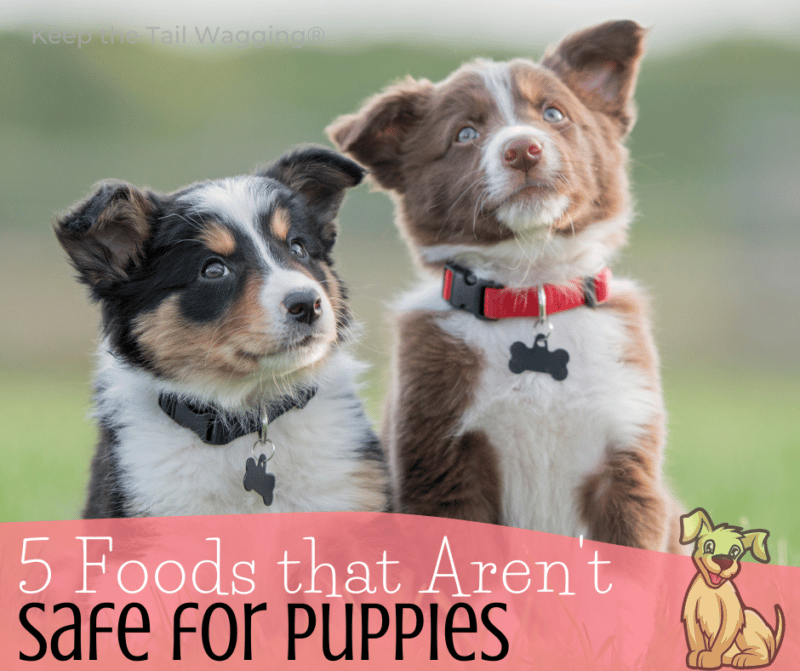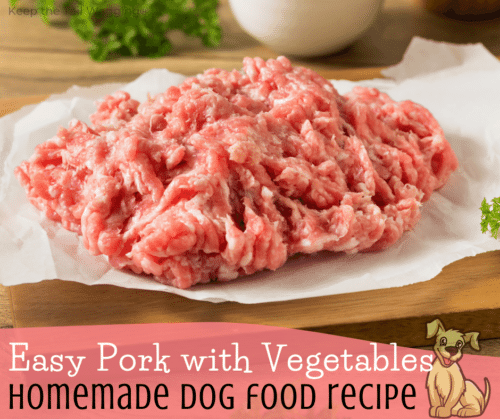Keep the Tail Wagging is supported by pet parents. I occasionally earn a commission (at no additional cost to you) when you click through an affiliate link to one of my favorite products. Thank you for your support. Read More
Thousands of articles list toxic foods for dogs, but few tell us what foods we should avoid for puppies. In 2022, we welcomed a puppy into our family. Bella is a mixed-breed puppy with Husky blue eyes, German Shepherd dimples, and a love for shoes. We feed our dogs a raw food diet, and as I learn more about our puppy's nutritional needs, I discovered five foods that aren't a good fit for puppies.
1 – Whole Raw Bones
I feed raw bones to my adult dogs for the vitamins and minerals, to clean their teeth, and to keep their jaw muscles in shape. Not all raw bones are a good fit for all dogs. I mainly feed rabbit, quail, and duck bones to my dogs. These are small and easy to consume; my dogs don't try to swallow them whole.
But they're not a good fit for puppies.
When Bella still had her puppy teeth, I didn't trust that they would be strong enough to crunch through a bone, so I stuck with air-dried chews from Real Dog Box, with her favorite being guinea fowl necks. Now that her adult teeth have come in, I'm slowly introducing her to duck feet. For the rest of her diet, she enjoys ground bones.
2 – Garlic
The myth that garlic is toxic to dogs persists. A study prompted this myth, but most pet parents don't realize the amount of garlic fed to dogs in the study isn't an amount any reasonable person would give to a dog. I give garlic to my dogs to support their immune system, as a natural detox, and to repel fleas and ticks. However, garlic isn't safe for dogs with anemia or puppies.
I have two supplements that have garlic as an ingredient:
3 – Peanuts
Not all nuts are safe for dogs, but peanuts are a hit in our house. I've been warned not to give my puppy peanuts because they can pose a choking hazard if she doesn't chew before swallowing. Bella is six months old now, so this one may be safe. It's essential to source the peanuts responsibly, avoiding products that may have sat in warehouses over a long period, making them more susceptible to toxic mold.
4 – Whole Apples
We have apple trees on our property, and our dogs love picking apples at the end of the summer. Sometimes, I'll remove the seeds (arsenic) from the apples; however, swallowing a few seeds isn't an issue for my big dogs. However, a puppy is smaller and it's not a good idea to test fate. I slice the apples and remove the seeds before feeding them to my puppy. Better safe than sorry.
5 – DIY Raw Dog Food
This one will surprise folks who know me as a staunch raw feeder, but I stand by this warning. I feed commercial raw to growing puppies because they need all their nutrients to support their rapid growth and development. The adjustments I need to make to my DIY meal prep to meet Bella's nutritional needs are too cumbersome. Feeding a commercial raw diet formulated for all life stages is much easier. It's also more expensive, but I'd rather spend more now and avoid veterinarian bills a few years from now due to feeding a nutritionally incomplete diet.
Making Better Choices for Our Dogs
In many ways, feeding my puppy is no different than feeding my adult dogs. She eats more calories, and her diet has more bone (calcium) and other nutrients, including more fat, to support her rapid growth. Suppose you recently brought home a puppy, and you'd like to feed a fresh food diet responsibly. In that case, I encourage you to connect with a certified canine nutritionist who can formulate a DIY diet or tell you how to adapt a commercially raw diet to meet your puppy's needs.
















